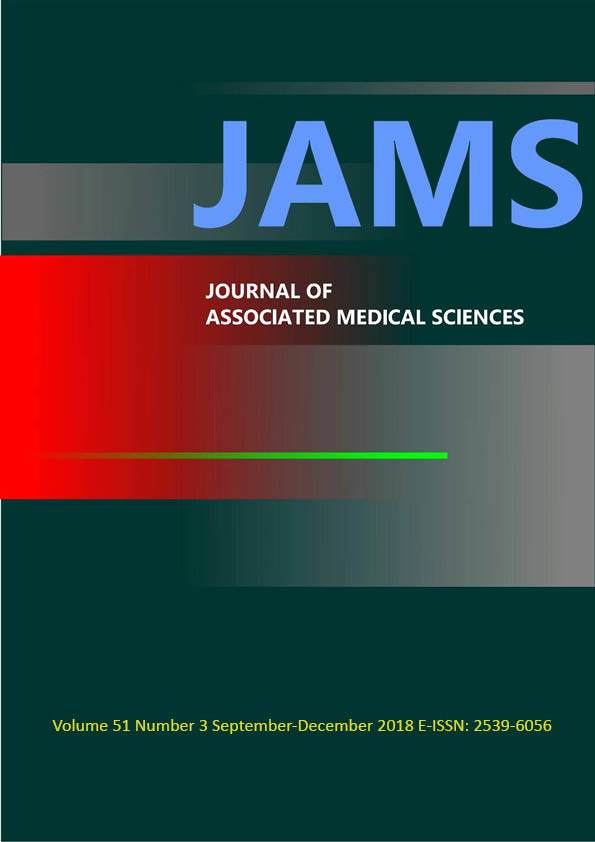Dosimetric validation of the eclipse Acuros XB dose calculation algorithm for a 6 MV photon beams
Main Article Content
Abstract
Background: Acuros XB (AXB) is a novel algorithm implemented to the commercial vender of Varian Eclipse treatment planning system. It is developed to improve the accuracy of dose calculation in external beam radiotherapy, especially in heterogeneity region.
Objectives: To evaluate dosimetric impact of AXB algorithm in basic beam characteristics and clinical applications according to IAEA TRS 430 protocol.
Materials and methods: Scanning percentage depth doses (PDDs) from CC13 ionization chamber and beam profiles at 10 cm depth from PFD diode of 6 MV from TrueBEAM linear accelerator were obtained in water phantom. Output factors were measured at 10 cm depth using CC13 chamber. Doses of fifteen cases in each 3D-CRT, IMRT, and VMAT techniques in solid phantom and CIRS thorax phantom were measured with CC13 chamber. All measurement results were compared with calculation from Eclipse treatment planning system (TPS) using AXB algorithm.
Results: The results showed good agreement between measured and calculated PDDs with δ1 (high dose & small dose gradient) less than 1.5% and δ2 (high dose & large dose gradient) within 1.5 mm. Measured profiles also displayed the coincidence results with TPS, which showed δ2 less than 2 mm, δ3 (high dose & small dose gradient) within 3%, δ4 (low dose & small dose gradient) within 3%, and δ50-90 within 2 mm as the recommendation from IAEA TRS 430 protocol. Maximum output factors differences were only -1.54%. Clinical plans exhibited the dose differences between measurement and calculation in 3D-CRT, IMRT, and VMAT of -0.12±0.38%, -1.59±0.93%, and 0.87±1.24% for homogeneous phantom and 0.27±0.29%, -0.60±1.05%, and -1.12±0.44% for inhomogeneous phantom, respectively.
Conclusion: Dose differences between measurement and AXB algorithm calculation are within the recommendation of IAEA TRS 430. AXB algorithm is acceptable for dose calculation in external beam radiotherapy.
Article Details

This work is licensed under a Creative Commons Attribution-NonCommercial-NoDerivatives 4.0 International License.
Personal views expressed by the contributors in their articles are not necessarily those of the Journal of Associated Medical Sciences, Faculty of Associated Medical Sciences, Chiang Mai University.
References
[2] Gregory AF, Wareing T, Archambault Y, Thompson S. Acuros XB advanced dose calculation for the Eclipse™ treatment planning system. Varian Medical System, Palo, Alto, CA. 2015. Avaliable from: https://www.varian.com/sites/default/files/resource_attachments/AcurosXBClinicalPerspectives_0.pdf
[3] Vassiliev ON, Wareing TA, McGhee J, Failla G, Salehpour MR, Mourtada F. Validation of a new grid-based Boltzmann equation for solver dose calculation in radiotherapy with photon beams. Phys Med Biol 2010; 55:581-98.
[4] Hoffmann L, Jørgensen MB, Muren LP, Petersen JB., Clinical validation of the Acuros XB photon dose calculation algorithm, a grid-based Boltzmann equation solver. Acta Oncol 2012; 51(3):376-85.
[5] Zifodya JM, Challens CH, Hsieh WL, From AAA to Acuros XB-clinical implications of selecting either Acuros XB dose-to-water or dose-to-medium. Australas Phys Eng Sci Med 2016; 39(2):431-9.
[6] Yeh PCY, Lee CC, Chao TC, Tung CJ. Monte Carlo evaluation of Acuros XB dose calculation Algorithm for intensity modulated radiation therapy of nasopharyngeal carcinoma. Rad Phys Chem 2017;140: 419-22.
[7] International Atomic Energy Agency. Commissioning and quality assurance of computerized planning systems for radiation treatment of cancer: TRS Report No 430. Vienna; Austria: 2004.
[8] Han T, Mourtada F, Kisling K, Mikell J, Followill D, Howell R. Experimental validation of deterministic Acuros XB algorithm for IMRT and VMAT dose calculations with the Radiological Physics Center’s head and neck phantom. Med Phys 2012; 39(4):2193-202.


